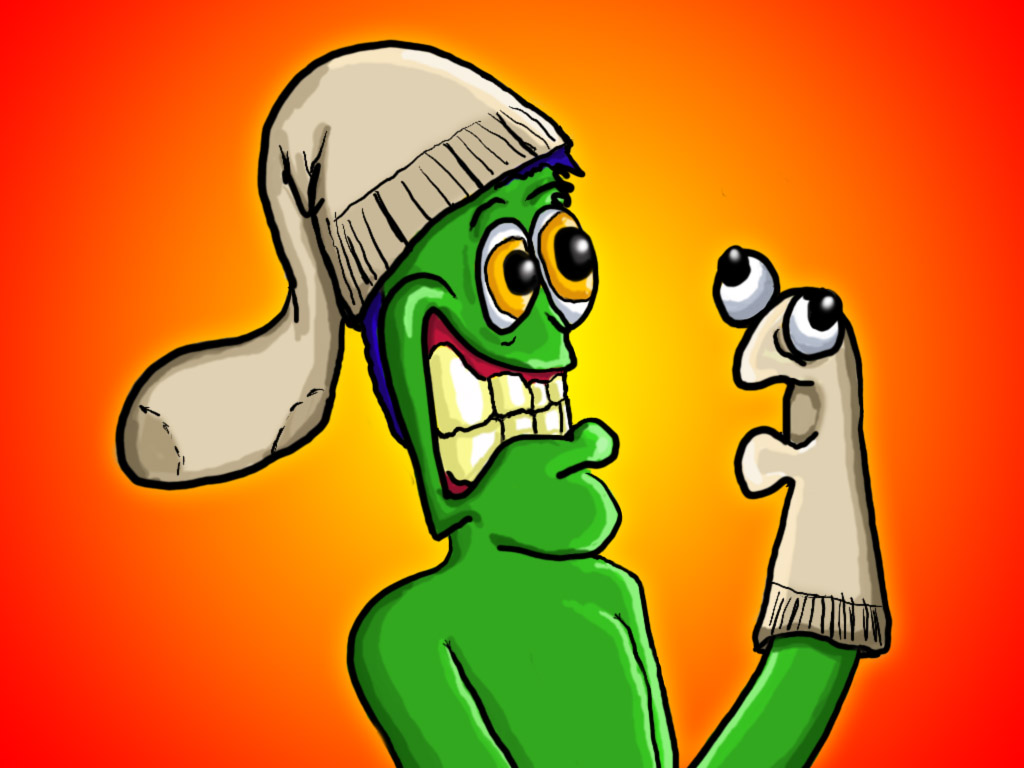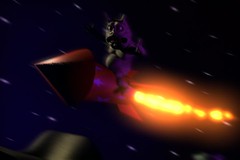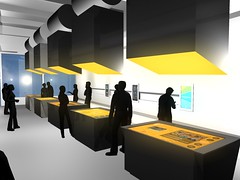
Illustration for Hennessy promotion

Illustration for Hennessy promotion
 Shortly after Apple announced that it would be releasing an iPhone SDK in October of 2007, I mused that the iPhone would be a major gaming platform by Christmas of 2008. The SDK finally appeared in March of 2008, and by December, even Apple was touting the iPod as a competitor to the Nintendo DS.
Shortly after Apple announced that it would be releasing an iPhone SDK in October of 2007, I mused that the iPhone would be a major gaming platform by Christmas of 2008. The SDK finally appeared in March of 2008, and by December, even Apple was touting the iPod as a competitor to the Nintendo DS.
A large percentage of the of the 27,000 apps currently available to the 30 million iPhones & iPod Touches that Apple has sold are games, and Apple in on track to break the billion download mark soon. iPhone/iPod Touch games recently swept the IGF Mobile Game Awards, and features in the new SDK, such as the addition of peripheral support, in-app purchases, peer to peer connections, push notification, and media library integration will allow games, as well as other apps, to become even richer and more complex. The iPhone/iPod is certainly a relevant, if not “major” gaming platform, and will only continue to be more so.
But what about Apple TV?
Apple has long called Apple TV a hobby, giving it little fanfare, and letting it seep into the living rooms of early adopters who simply wanted to stream media to their HDTVs. However, if Apple were to create an SDK for the Apple TV, it would open the doors for developers to create a myriad of useful apps as well as games, all of which could interface with with users’ iPhones and iPod Touches. The video hardware, which can easily handle high def movies with surround sound, is lacking for Xbox-level graphics, however simpler games are certainly possible. Board games such as Scrabble are an obvious example, as the TV can be the “board” and each player can view their pieces and interact with the game using their iPhones, however, the real potential lies in utilizing the multitouch, motion sensor, camera, and other abilities available in the iPhone. I would not be surprised if within a year Apple introduced a combined (or complementary) SDK for both iPhone and Apple TV. The next iPhone is already rumored to have a significantly more powerful graphics chip, and a similar upgrade to the next Apple TV could make them quite a pair, for gaming or otherwise.
iTunes was just the beginning
Apple has already built the framework for a full digital ecosystem to stream and control a variety of media across a plethora of devices, and they have created an SDK & App Store that has, within a year, birthed a major software platform. All they need to do now is connect the dots and provide an SDK for an upgraded Apple TV. The result: programs on computers, iPhones, iPods, and Apple TVs will network together not only to stream photos, music & video as before, but to do anything else a developer can dream up, whether it be using an iPhone to control a Keynote presentation on an Apple TV, or for multiplayer 3D games that surpass the combined features of the Wii & Xbox 360.
2007
Animated flash-based leaderboard & announcement system for the Championship Gaming Series portion of the Game U Tour.
As part of the Game U Tour, I traveled to universities across the US, and helped set up a few dozen gaming kiosks for students to come play. While running the Championship Gaming Series portion, I was responsible not only for running the tournaments, but for creating and running the electronic leaderboard & announcement system.
The animated through several announcements and brackets, pulling the data from a file on my laptop.
I later created another E-Leaderboard system for Game Live Events to use in their NASCAR Challenge Tour.
2001
Admittedly one of the most sophomoric worlds (I was a sophomore, after all) in BVW history, we created a 3D version of whack-a-mole, but with a ring of filthy toilets, and no moles. Very silly, and lots of fun, there were consistently lines of people in the computer lab who wanted to help us “test” it.
The extra little joke (that was was appreciated by most) was that we “borrowed” some models from other worlds, so the other students got the surprise of seeing some of their creations whacked with a plunger…and yes, that is Randy’s face, as well as the faces of our group, popping out in the end.
by Zach Beard, Sterling Ely, Jenica Rangos & Alok Menghrajani
2002
What this BVW world lacked in narrative, it made up for in sheer fun. (Ok, it was a bit glitchy, but BVW project isn’t?) The premise? Take a typical breakout/arkanoid/bricks style game, and make it not only 3D, but fully immersive. The player wears a headmount and holds a shield-like paddle with which they must hit a ball down corridors in all directions to break bricks. I’ve always wanted to play breakout like this, so it was pretty satisfying to build it so I could finally try it out.
In addition to painting the textures, such as on these virtual paddles, I built the real-life controllers for the game. Basically it was just a frisbee with a handle, a spot to mount a motion tracker, and a button to release the ball while using the grabby paddle.
by Adrian Perez, Sterling Ely, Amanda Kraemer & Ryan Freytag
2001
Timorous Timmy is afraid there’s a monster under his bed…
Of course, he’s right. The monster listens in from his lair underneath the bed to try & figure out what he needs to troll out near the edge so that he might catch himself a tasty treat…
I was the modeler for this project, but couldn’t resist giving Mr. Monster a cursory paint job before passing him off to Amanda.
Some original character idea sketches

Over the years, I’ve worked with 3D Studio MAX, Maya, and even trueSpace to model, texture, light & animate 3D characters & environments.
 During an animation class at Carnegie Mellon, I created Hamsters in Space in Maya, and later worked with a small team to create Playin with Fire.
During an animation class at Carnegie Mellon, I created Hamsters in Space in Maya, and later worked with a small team to create Playin with Fire.
While taking the Building Virtual Worlds class, I used 3D Studio MAX to model and paint characters & environments for immersive virtual reality worlds such as The Quest for the Holy Grail and The Duel. (I also did some keyframe and motion-capture animation for these, but most of the animations for BVW projects were scripted by the programmer)
Most recently, however, I have been using 3DS MAX to create animations and still renderings of proposed architectural spaces and media designs for clients of Local Projects. The flythrough of SeaGlass: The Carousel at The Battery is currently being used by The Battery Conservancy to raise funds to complete building, the  Astor Place redesign is still going through the proposal process, and the New York Visitors Center is now open to the public. A flythrough I produced with Local Projects was also instrumental in Local Projects & Thinc Design winning the proposal for the National September 11th Memorial Museum, but I’m not allowed to show that animation to anyone.
Astor Place redesign is still going through the proposal process, and the New York Visitors Center is now open to the public. A flythrough I produced with Local Projects was also instrumental in Local Projects & Thinc Design winning the proposal for the National September 11th Memorial Museum, but I’m not allowed to show that animation to anyone.
I modified an existing template to create this site for Vortex Zoom Encoder by Immersive Media Research.
One of the things I love about WordPress, is, of course, the huge amount of flexibility it provides. In addition to constant updates and improvements to the system and CMS, its modular nature allows me to plug in all sorts of new features and abilities with minimal coding.
Google Friend Connect is the latest handful that I’m throwing at the wall that is sterlingely.com, and so far, I like how it sticks. The idea behind GFS is simply to “make the web more social” by building a social networking system (based on your GMail account) that exists outside of any one website.
For example, instead of my Facebook “wall” which is private and on Facebook, I can now have a “wall” on sterlingely.com where anyone (or just approved friends) can write public comments. (Notice the modules to the lower right) Furthermore, I can use the GFC comment system instead of the WordPress comment system for comments on every post or page on my site.
And there’s the rub: Now I’ve reached a point where WordPress and Google Friend Connect overlap. As you’ll notice if you view any particular page or post on this site, at least for now, I have 2 forms of feedback on every page. Both can be completely open, allowing anyone to write an anonymous comment, or both can be locked down to only registered users. (Currently, only the WordPress comment system is active on each page)
For now I’ll keep both around: Google Friend Connect is still in its infancy, and has great potential, but I ain’t givin up on WP’s built-in commenting system yet!